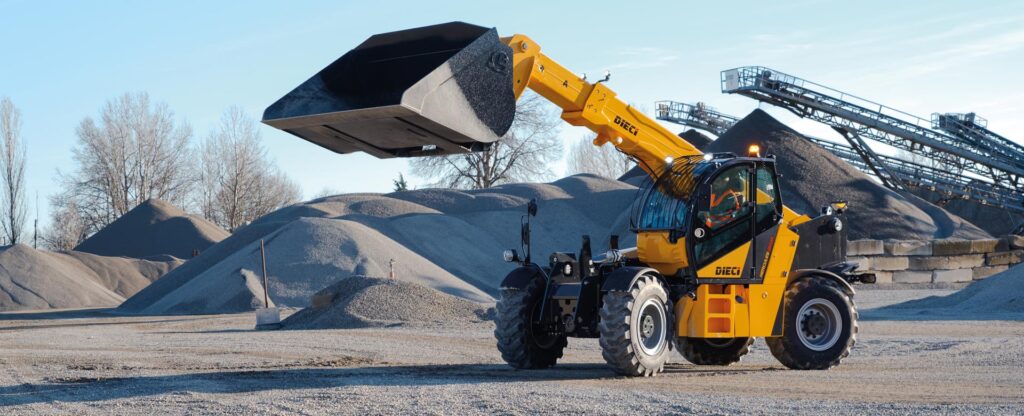
At Rygor Plant, we specialise in providing industry-leading machinery solutions, including the highly sought-after Dieci telehandler range. If you’re in construction, agriculture, warehousing, or industrial maintenance, a telehandler (also known as a telescopic handler) could be one of the most versatile and valuable machines in your fleet.
This detailed FAQ guide answers the most common questions surrounding telehandlers—what they are, what they’re used for, how they work, and why Dieci telehandlers are a top choice.
What is a telehandler?
A telehandler, short for telescopic handler, is a powerful lifting machine that features a telescopic boom capable of extending forwards and upwards. This gives it the unique ability to lift loads to elevated heights or hard-to-reach places—something a standard forklift cannot do.
Unlike a fixed mast forklift, a telescopic handler can:
- Extend loads forward and upward using its boom.
- Operate on rough terrain thanks to robust tyres and four-wheel drive.
- Attach a variety of tools like forks, buckets, or lifting jibs.
In short, if you’re wondering, what is a telehandler, it’s best described as a cross between a forklift, crane, and loader—delivering outstanding versatility in a wide range of working environments.
What is a telehandler used for?
A telehandler can be used in:
Construction
- Lifting and placing pallets of bricks, blocks, and roofing materials.
- Moving supplies to upper floors or scaffold platforms.
- Handling tools and equipment across busy sites.
Agriculture
- Moving hay bales or feedstock.
- Cleaning out barns with bucket attachments.
- Transporting fertiliser or seed bags around the farm.
Warehousing and Industrial
- Accessing high storage racks.
- Loading/unloading heavy materials.
- Working in confined or indoor spaces with compact models.
Utilities and Maintenance
- Lifting personnel for overhead work (with man basket attachments).
- Reaching infrastructure in hard-to-access areas.
Thanks to their flexibility, telescopic handlers are one of the most important machines in modern construction and farming operations.
What are the benefits of using a telescopic handler?
Here’s why a telehandler stands out from other machinery:
- Extended Reach: Lift vertically or forward into hard-to-reach places.
- Adaptability: Switch between forks, buckets, baskets, and more.
- Manoeuvrability: Many models feature four-wheel drive and steering.
- Stability: Outriggers and stabilisers help handle heavy loads safely.
- All-Terrain Performance: Works effectively on muddy, uneven, or sloped surfaces.
Why choose a Dieci telehandler?
- High performance across a wide range of lifting capacities and heights.
- Comfortable cabs with great visibility and ergonomic controls.
- Advanced technology including intuitive dashboards and safety systems.
- Reliable components built for harsh environments and heavy workloads.
- Easy servicing to reduce downtime and increase productivity.
At Rygor Plant, we proudly supply the full range of Dieci telehandlers, complete with aftersales support and expert guidance.
What types of Dieci telehandlers are available?
Telehandlers come in a few different types, each designed for specific applications and environments. Understanding the differences can help you choose the right machine for your needs.
Fixed Telehandler
A fixed telehandler, also known as a rigid telescopic handler, has a boom that only moves up and down or extends forwards. It does not rotate. This is the most common type of telehandler, ideal for lifting and placing loads in construction, agriculture, and industrial settings.
Rotating Telehandler
A rotating telehandler features a boom mounted on a turret, allowing it to rotate 360° without moving the chassis. This makes it ideal for confined job sites where repositioning the machine isn’t feasible.
Compact Telehandler
These smaller models are ideal for low-clearance or restricted-access sites where a full-size telehandler wouldn’t fit. Compact telehandlers are common in agriculture, landscaping, and property maintenance.
Electric Telehandler
Electric telehandlers are a growing category in response to stricter emissions regulations and a demand for quieter, more sustainable machines. Ideal for indoor use, urban projects, or green construction sites.
How does a telescopic handler work?
Understanding how a telehandler functions can help operators use it safely and efficiently.
Main components:
- Telescopic Boom: Extends and retracts to adjust height and reach.
- Hydraulic System: Powers the boom, steering, and lifting mechanisms.
- Operator Cab: Equipped with joystick controls, display screens, and safety systems.
- Wheels and Chassis: Designed for off-road use with optional stabilisers for added safety.
- Attachments: Easily interchangeable via quick-hitch systems.
The operator uses the joystick or control panel to raise/lower or extend/retract the boom, allowing the load to be moved precisely and safely.
What attachments can be used with a telehandler?
One of the biggest advantages of using a telescopic handler is its wide compatibility with multiple attachments:
- Pallet Forks: Standard for lifting palletised materials.
- General Purpose Buckets: For loading loose materials like sand or soil.
- Man Baskets (Platforms): For lifting personnel to work at height.
- Crane Jibs: Convert your telehandler into a mobile crane.
- Bale Clamps/Grabs: Ideal for hay or wrapped silage in farming.
- Sweepers or Blades: For cleaning or site prep.
How much can a telehandler lift?
The lifting capacity of a telehandler depends on the model. Key specs include:
- Lift Height: Typically between 4 to 20 metres.
- Max Capacity: Ranges from 2,500 kg to over 20,000 kg on heavy-duty models.
- Forward Reach: Up to 18 metres on certain machines.
Why choose Rygor Plant for Dieci telehandlers?
At Rygor Plant, we offer a comprehensive range of Dieci machines, backed by expert advice from our experienced plant specialists. Whether you’re looking to purchase or hire, we provide flexible finance and rental options to suit your needs.
As an authorised dealer, we also supply genuine Dieci parts and attachments, ensuring your equipment stays in peak condition. With nationwide delivery and dedicated aftersales support, Rygor Plant is more than just a supplier—we’re your long-term equipment partner.
Contact Rygor Plant today for expert guidance and competitive pricing on the full range of Dieci telehandlers.
